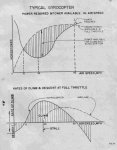Chuck B., Harry and others: you remember when we learned to fly using towed gyrogliders. This method had its charms and advantages.
One DISadvantage of it was that the available thrust (from the tow car) was for all practical purposes infinite. There was no "back side of the power curve." You could gyroglide all day at 30 mph -- in fact, you might as well stay slow, since you got a longer flight on each pass that way.
SO TRUE, DOUG. WE HAD PERMISSION TO USE A MILE AND A HALF OF BRAND NEW CONCRETE, DIVIDED HI-WAY THAT WAS NOT OPEN FOR TRAFFIC. THE ONLY "OBSTRUCTION" WAS THE HIGH POWER LINES THAT INTERSECTED THE HI-WAY ABOUT 1/4 MILE FROM THE NORTH END. YOU WOULD BE DOWN LOW FOR A TOUCHDOWN ANYWAY. THE THINGS I DID IN THAT GLIDER WHILE SOLO, UGH... IF THAT ROPE WOULD HAVE SNAPPED...
TALK ABOUT LONG FLIGHTS...I TESTED THIS FELLA'S PONTOON GLIDER ON A RATHER LARGE LAKE AND I WAS AIRBORNE FOR MAYBE 25 OR 30 MIN. AND WAS HAVIN' A BALL; ONLY ONE OTHER BOAT IN THE WATER. WE HAD NO COMM. AND THE OWNER WANTED TO TRY IT OUT HIMSELF SO, HE STARTED A STEADY SLOWDOWN TO GIVE ME THE MESSAGE THAT HE WANTED ME TO SET 'ER DOWN.

This habit of slowness often resulted in a mush-in when pilots converted to power. There are many accounts of "backside" mush-ins in old issues of the PRA mag from this era.
MY FIRST POWERED FLIGHT WAS IN A USED B7 I BOUGHT. IT WAS NOT DEMO'ED, BUT I DID FLY IT UNDER TOW FOR ABOUT AN HOUR BEFORE I DECIDED TO FLY WITH POWER. AS I'VE SAID BEFORE...I DIDN'T NEED TO READ NO STINKIN' BENSEN MANUALS, RIGHT?!

ANYWAY, I CRANKED 'ER UP AND TAXIIED THE FULL LENGTH OF THE RUNWAY, FACED INTO THE WIND, USED THE "ARMSTRONG" SPINUP, SAT IN AND STARTED SLOWLY ROLLIN'. WITH THE STICK FULL BACK AND FULL THROTTLE, RRPM LOOKIN' GOOD, SHE LIFTED OFF. GOT ABOUT 5-6 FT. OFF THE GRASS AND MUSHED BACK TO THE GROUND. WHAT'S GOIN' ON?!
TAXIIED BACK FOR ANOTHER TRY. IDENTICALLY THE SAME AS THE FIRST ATTEMPT. TRIED ONE MORE TIME...THE SAME RESULT. NOW I'M PISSED. I'M THINKIN' THIS BABY DON'T HAVE ENOUGH POWER TO FLY. I'M STANDING AT THE END OF THE STRIP WHEN IT HITS ME. :boink: THE GLIDER HAD ROCK STEADY PULLING POWER WITH FULL AFT STICK FOR CLIMBING...I DIDN'T.
ON THE NEXT TRY, WHEN I WAS ROLLING AND BROKE GROUND...FORWARD WITH THE STICK...NOSE CAME LEVEL...PICKED UP SPEED AND AWAY WE WENT WITH A SHAKE OF THE HEAD AND A BIG SMILE. LEARNED A HEAP RIGHT THEN AND IT STUCK WITH ME.


